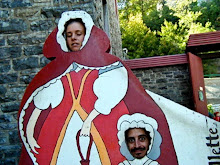Sunday, March 7, 2010
A Sad Day for Bees....
I have been on the road for 2 weeks, visiting family and friends and taking lots of photos. My brain is about to explode from everything that I've experienced - which was entirely the point. Although I'm thrilled to share my new ideas and images, I'm also way behind on the home front. A broody hen, taxes, a hoop house to plant, propaganda to design...everything awaits.
While I was away I got word that my bees were flying over at the Blue Heron Farm. This news was hugely relieving as last year 2 of my hives were split in half, with the new hives being comprised of brand new equipment. This means that partway into the season I had 2 hives facing a lot of work, just to make it through the winter. With new equipment, bees are responsible for drawing out enough wax (imagine honeycomb) to raise brood and store food. To make things worse, it started raining a lot, and that prevents bees from obtaining the calories and supplies they need to 'make it all happen.' In the fall I was definitely concerned about the strength of certain hives and began feeding them sugar syrup until it got too cold. {If any of you are interested in keeping bees, I recommend that you explore Beekeeper Linda's blog, and consider reading Ross Conrad's book Natural Beekeeping.}
I was unsure if the bees would really be ready for food, but last year when the sun starting coming out more often, the farmers noticed ravished bees in their chicken feed. I decided to make a big batch for my 6 hives, so that I would have lots to take me through the warming weather. I mix sugar and water 1:1 and cook it on the stovetop until the mixture is clear. I then allow it to cool and pour it in a 5 gallon bucket with a honey gate (the yellow plastic mechanism has wingnuts that allow you to control the speed in which the spout opens and closes. I've found that it works pretty spectacularly when canning things like ketchup, too.) I happen to have a lot of food service jelly jars from my waitressing days to use as feeders for the bees; after filling with sugar syrup, I screw on lids with holes drilled out in a pattern that mimics the shape of the hole in a hive's inner cover. The jars get turned upside down and sit atop slats of wood positioned over the inner cover, inside a medium super. This allows space for the bees to come up and get the food, and gravity controls the flow. I covered the jar lids with duct tape for the ride over to the farm.
I was greeted at the farm by Adam and Christine's chickens aka 'the Pretty Girls.' Because mud season is upon us, I brought a sled to pull all my stuff to the bee yard, instead of trying to drive back there. On a side note, we don't have a rooster at our house, and today I saw my first chicken love. Chicken porn? Call it what you will, but yikes either way...
I used to differentiate my hives just by color, but that soon went by the wayside. Eventually they became all mixed up because my schedule means that everybody 'gets what they get'; be they bee, chicken, niece, nephew, or husband. I thought about numbers, letters, or stencils, but then I found these Wizard of Oz stickers for 99 cents. Sold. There are 8 different images, making them within my price range (bees can get expensive if you don't keep your head.) I unsuccessfully set out a hive last summer to try and catch a swarm, and that one is labeled with the Wicked Witch. Heh, heh...
When I got to the bee yard, I was disappointed to find that only one of the hives seemed to be active. Strangely, this was the hive I had written off as the weakest of the bunch last Fall - I was so sure it would fail. I lifted the covers on the rest and didn't hear any buzzing. I've never lost a hive before, which is completely out of the norm, but I feel distraught nonetheless. I'm unwilling to take things apart and investigate until the weather is much warmer, just in case there is a small population still hanging on, tightly clustered in the center of the hive. This is wishful thinking, I assure you. But when I do go back to clean out the hives, I'll be able to see what happened to the bees - I suspect that they starved. Their death is undoubtedly a regular result of keeping bees in northern climates; Vermont has not seen Colony Collapse Disorder, or at least that is the position of the Vermont Beekeepers Association. This seems to make sense as we don't have a lot CCD stress factors, such as monoculture, overused pesticides, and hives that are trucked great distances (as you'll find at California almond groves, for example.)
So, a sunny, depressing day. And I have about 35 pounds of sugar syrup! That's a lot of lemonade to make...






















